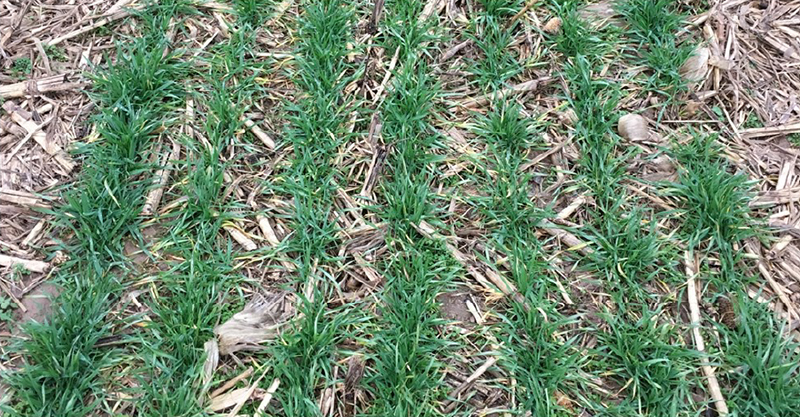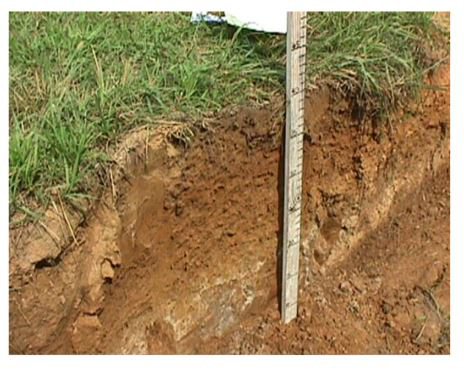100 Years of UKREC Research: Soil Improvements
100 Years of UKREC Research: Soil Improvements
Published on April 1, 2025

By Susan Baniak and Jennifer Elwell, UK Marketing and Agriculture Communications
According to reports from Samuel Lowry, the Princeton station's first superintendent, work focused on land reclamation and soil fertility improvements as soon as the land was purchased in 1925. The earliest projects established the benefits of long-term crop rotation for grain crops planted after grasses and legumes. One hundred years later, environmental sustainability continues to drive research at the University of Kentucky Research and Education Center.
No-Till Farming
Since the 1960s, UKREC has been at the forefront of the no-till movement both in Western Kentucky and globally. UKREC’s early role in supporting the adoption of no-till farming techniques, which leave the soil undisturbed during planting, has been fueled by its extensive research on nitrogen and fertility management, weed control strategies, crop rotation benefits, and the use of cover crops to enhance soil health. In the 21st century, that research has continued with ongoing studies into the use of no-till techniques for wheat, corn, and soybean production.
Studies by UKREC researchers, such as extension soils specialist Lloyd Murdock and agronomist James Herbek, have demonstrated the ability of no-till farming practices to improve soil health and reduce erosion while also maintaining or slightly increasing crop yields. UKREC researchers, working in collaboration with groups such as the Kentucky Small Grain Growers Association and the Kentucky Soybean Board, conducted long-term comparative studies of tilled and no-till wheat systems, examining the effects of each on double-cropped soybeans and corn. This research demonstrated that no-till systems could achieve equal or greater yields with proper management adjustments to planting practices, seeding rates, weed control, nitrogen, and residue management as needed.
The continued work to refine no-till methods also sparked innovative solutions to address its challenges. Among the advances launched by Kentucky farmers to make no-tilling easier was a row cleaner patented by Howard Martin in 1988. The invention featured two angled, toothed wheels that swept away crop residue without disturbing the soil. The design enabled seed to make better contact with the soil and extended the planting window for no-till farming. Murdock and Herbek conducted some of the first research on the row cleaner’s effectiveness at UKREC in Princeton. Murdock and Martin became good friends, according to John Martin, Martin's son.
Howard Martin sold the patent to John Deere in 1991. When Deere farmed out the manufacturing of the cleaners to a third party, Martin, a farmer and self-taught machinist, was dissatisfied with the quality of the results and proposed to Deere that he could manufacture it for Deere himself, John Martin said.
“It was a perfect storm,” John Martin said. “We became manufacturers, and it was a huge learning curve. We went through a lot of scrap metal being thrown away in that first year. But it’s been 30 years, and it’s done really well.”
Martin said Murdock would bring visitors from as far as Argentina and Australia to his family’s 40-acre no-till farm site for row cleaner demonstrations and extensive discussions about soil health and no-till techniques.
“It was just amazing,” Martin said. “And these people were just in awe that a little farmer from Western Kentucky had a hold of a UK professor—a soil scientist, in fact—on their actual farm. My dad really coveted those relationships.”
Today, Martin-Till ships its row cleaners and related products worldwide from its headquarters and manufacturing facility in Elkton, Kentucky. Martin-Till has also continued to innovate since the introduction of its original row cleaner design, with improved attachments that include a closing wheel and a fertilizer opener.
With UKREC’s continued research and support, the adoption of no-till farming and crop rotation has increased among Western Kentucky farmers, resulting in improved soil conservation and reduced input costs. Farming operations around the world have looked to UKREC and Western Kentucky as both pioneers and continuing innovators in the global expansion of no-till farming systems.
Soil Sampling
Collecting a good representative soil sample is the first step in assessing a farmer’s fertilizer needs. A sample that does not reflect actual soil conditions can lead to misleading results and costly over- or under-fertilization.
As no-till farming gained popularity in Western Kentucky, UKREC faculty and staff recognized that the common practice of sampling to the depth of a conventional tilling operation (typically six to eight inches) didn’t provide an accurate representation for soils that were not being regularly turned. Based on the results of their studies, soil sampling depth recommendations for non- or reduced-tilled areas were changed to three to four inches for pastures and one to two inches for no-till and minimum-till plantings. The change helped no-till farmers make more informed decisions about fertilizer applications, improving their productivity while also preserving the health of the soil and the environment.
Crop Rotation Revisited
Although research at the station in the 1920s and 1930s had established the benefits of long-term crop rotation for grain crops, the practice declined during the 1950s, 1960s, 1970s, and 1980s throughout much of the state as grain cropping intensified. The yield benefits of crop rotations were often overlooked, as fertilizers and pesticides were used as substitutes.
Agronomists James Herbek and Lloyd Murdock initiated an evaluation of crop rotation involving corn and soybeans using modern production technologies in 1981; the research continued through 1987. The research results were startling. The studies showed an average crop rotation yield advantage of 10 bushels of corn per acre when corn was grown alternately with soybeans and a five-bushel-per-acre increase for soybeans when grown alternately with corn. As a result of this research, crop rotation is once again considered an essential component of cropping systems in major grain-producing areas.
Soil Compaction
Soil compaction has always been a concern for Kentucky farmers, but the extent of the problem and the conditions that contribute to it had never been thoroughly documented. Studies conducted by UK agronomists and agricultural engineers in the late 1990s and early 2000s found that one-third of the fields surveyed in Kentucky had severe compaction issues that affected yield. UKREC research indicated that corn yield was reduced by as much as 98 percent for soil with severe compaction to a depth of 12 inches.
In the 1980s, UK Biosystems and Agricultural Engineering professor Larry Wells and extension soils specialist Lloyd Murdock, in collaboration with innovative machinist Dale Schrull, led the effort to develop a lower-priced soil penetrometer as a cost-effective tool for quantifying soil resistance to pressure. While soil resistance is a more accurate measure of soil strength than compaction, it can offer a good indication of compaction when soil moisture conditions are near full capacity. Almost every county Extension office in Kentucky has been equipped with a soil penetrometer, and agents are trained in its use, helping the state gather valuable insights into the extent of soil compaction and its effects on Kentucky agriculture.
Research conducted by UKREC-based scientists and extension staff in recent years has aimed to help farmers identify and remediate fields where compaction limits production and to modify production practices to prevent future problems caused by machinery traffic and tillage.
Fragipan Remediation
 UK soil scientists in Princeton and Lexington conducted laboratory, greenhouse, and field experiments throughout the 2010s to gain a better understanding of the fragipan. This naturally occurring restrictive soil horizon can limit water movement and root growth just a few feet below the soil on some Kentucky farms.
UK soil scientists in Princeton and Lexington conducted laboratory, greenhouse, and field experiments throughout the 2010s to gain a better understanding of the fragipan. This naturally occurring restrictive soil horizon can limit water movement and root growth just a few feet below the soil on some Kentucky farms.
The fragipan is present in roughly 2.7 million acres of Kentucky soil, primarily in the western half of the state, and in approximately 50 million acres across the United States. Finding ways to break it down had proven to be a challenge for farmers and researchers alike until UKREC research showed that planting annual ryegrass degraded the fragipan and increased yields more effectively than other chemical or plant alternatives.
Annual ryegrass, also known as Italian ryegrass, can be a significant nuisance for farmers, particularly in wheat fields and no-till corn and soybean fields, due to its resistance to herbicides, its tendency to aggressively compete for nutrients and sunlight, and its rapid growth rate and prolific seed production. But lab results showed that the annual ryegrass produced chemicals that dissolved specific cementing agents in the fragipan and turned portions of it back into productive soil particles. Trials also indicated that the degradation process was cumulative over multiple seasons. The research breakthrough offered new prospects for potential long-term improvements to those whose farming operations had been limited by the restrictive fragipan.
